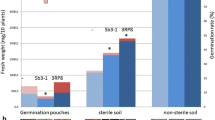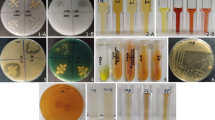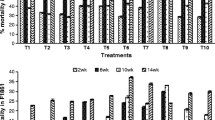Abstract
Single isolates of bacterial endophytes, isolated from the nematode antagonistic plant species African (Tagetes erecta L.) and French (T. patula L.) marigold, were introduced into potatoes (Solanum tuberosum L.). Several bacterial species possessed activity against root-lesion nematodes (Pratylenchus penetrans) in soils around the root zone of potatoes, namely: Microbacterium esteraromaticum, Tsukamurella paurometabolum, isolate TP6, Pseudomonas chlororaphis, Kocuria varians and K. kristinae. Of these, M. esteraromaticum and K. varians depressed the population densities of root-lesion nematodes without incurring any yield penalty (tuber wet weight). No significant differences were found in the total numbers of P. penetrans nematodes, rhabditid nematodes or `other' parasitic nematode species within the root tissues of bacterized potato plants compared to the unbacterized check. Overall, tuber fresh weights and tuber number were equal to or significantly lower (P\le0.05) in bacterized plants than their unbacterized counterpart. We conclude that endoroot bacteria from Tagetes spp. can play a role in nematode suppression through the attenuation of nematode proliferation. We propose that these nematode control properties are capable of transfer to other crops in a rotation as a beneficial `residual' microflora – a form of beneficial microbial allelopathy.
Similar content being viewed by others
References
Bakker J, Gommers F J, Nieuwenhuis I and Wynberg, H 1979 Photoactivation of the nematicidal compound a-terthienyl from roots of marigolds (Tagetesspecies): A possible singlet oxygen role J. Biol. Chem. 254, 1841–1844.
Barazani O and Friedman J 1999 Allelopathic bacteria and their impact on higher plants. Crit. Rev. Plant Sci. 18, 741–755.
Barker K R and Koenning S R 1998 Developing sustainable systems for nematode management. Annu. Rev. Phytopathol. 36, 165–205.
Becker J O, Zavaleta-Mejia E, Colbert S F, Schroth M N, Weinhold A R 1988 Effect of rhizobacteria on root-knot nematodes and gall formation. Phytopathology 78,1466–69.
Bensalim S, Nowak J and Asiedu S 1998 A plant growth promoting rhizobacterium and temperature effects on performance of 18 clones of potato. Am. Pot. J. 75, 145–152.
Bingefors S 1982 Nature of inherited nematode resistance in plants. InPathogens, Vectors and Plant Diseases: Approaches to Control. Eds. K F Harris, K Maramorosch. pp. 187–218. Academic Press, New York.
Bolton H J, Fredrickson J K and Elliott L F 1993 Microbial ecology of the rhizosphere. InSoil Microbial Ecology. Ed. F B J Metting. pp. 27–63. Marcel Dekker, New York, USA.
Bridge J 1996 Nematode management in sustainable and subsistence agriculture. Annu. Rev. Phytopathol. 34, 201–225.
Brodie B B 1984 Nematode parasites of potato. InPlant and Insect Nematodes. Ed. W R Nickle pp. 3–17. Dekker, New York, USA and Basel, Switzerland.
Conn K L, Nowak J and Lazarovits G 1997 A gnotobiotic bioassay for studying interactions between potatoes and plant growthpromoting rhizobacteria. Can. J. Microbiol. 43, 801–808.
Duncan L W 1991 Current Options for Nematode Management Annu. Rev. Phytopathol. 29, 469–490.
Dusenberry D B 1987 Prospects for exploiting sensory stimuli in nematode control. InVistas on Nematology. Eds. J A Veech, DW Dickson. pp. 131–135. Soc. Nematol., Hyattsville, MD.
Frederick J J and Tarjan A C 1989 A compendium of the genus PratylenchusFilipjev 1936 (Nemata: Pratylenchidae). Revue de Nematologie 12, 243–256.
Frommel MI, Nowak J and Lazarovits G 1991 Growth enhancement and developmental modifications of in vitrogrown potato (Solanum tuberosumssp. tuberosum) as affected by a nonfluorescent Pseudomonassp. Plant Physiol. 96, 928–936.
Geier P W 1966 Management of insect pests. Annu. Rev. Entomol. 11, 471–90.
Genstat 1993 Genstat 5 Committee of the Statistics Department, Genstat 5 (Release 3), Rothamsted Experimental Station. Oxford, U.K.: Oxford Science Publications, Clarendon Press.
Glick B R, Patten C L, Holguin G and Penrose D M 1999 Biochemical and Genetic Mechanisms Used by Plant Growth Promoting Bacteria. Imperial College Press, London, UK.
Gommers FJ, Bakker J 1988 Mode of action of alpha-terthieyl and related compounds may explain the expressant effects of Tagetesspecies on populations of free living endoparasitic plant nematodes. Bioact. Mol. 7, 61–69.
Gommers F J, 1972 Increase of the nematicidal activity of a-terthienyl and related compounds by light. Nematologica. 18, 458–462.
Harman G E and Lumsden R D 1990 Biological disease control. InThe Rhizosphere. Ed. J M Lynch. pp. 259–280. John Wiley & Sons, London, UK.
Hoffman-Hergarten S, Keuken O, Gulatin M and Sikora R A 1997 Yield responses and biological control of root knot nematode, Meloidogyne incognita, treated with Bacillus cereus. InPlant growth promoting rhizobacteria-present status and future prospects. Proc. Int.Workshop Plant-Growth-Promot. Rhizobacteria. Eds. A Ogoshi, K Kobayashi, Y Homma, F Kodama, N Kondo and S Akino. pp. 364–367. 4th Jpn.-OECD Joint Workshop, Sapporo. JPN.
Hooper D J 1986 Extraction of nematodes from plant material. InLaboratory Methods for Work with Plant and Soil Nematodes. Ed. J F Southey. pp. 51–58. Reference Book 402, HMSO, London, UK.
Kagan J, Kagan E, Patel S, Perrine D and Bindokas V 1987 Lightdependent effects of alpha-terthienyl in eggs, larvae and pupae of mosquito Aedes aegypti. J. Chem. Ecol. 13, 593–603.
Kerry B A 1990. An assessment of progress toward microbial control of plant-parasitic nematodes. J. Nematol. 22, 621–623.
Kimpinski J and McRae K B 1988 Relationship of yield and Pratylenchusspp. population densities in Superior and Russet Burbank potato. Ann. App. Nematol. 2, 34–37.
Kimpinski J, Arsenault W J and Sturz A V 2001 Differential effect of nematicide treatments on tuber yields in early-and late-maturing potato cultivars. Plant Pathology 50, 509–514.
Kimpinski J 1993 Nematodes. InSoil Sampling and Methods of Analysis. Ed. M R Carter. pp. 333–339. Lewis Publishers Boca Raton, Florida, USA.
Kloepper J W, Rodriguez-Kábana R, McInroy J A and Young R W 1992 Rhizosphere bacteria antagonistic to soybean cyst (Heterodera glycines) and root-knot (Meloidogyne incognita) nematodes: identification by fatty acid analysis and frequency of biocontrol activity. Plant Soil 139, 75–84.
Kobayashi D Y and Palumbo J D 2000 Bacterial endophytes and their effects on plants and uses in agriculture. InMicrobial Endophytes. Eds. C W Bacon and J F White Jr. pp. 199–233. Marcel Dekker, New York, USA.
Lazarovits G and Nowak J 1997 Rhizobacteria for improvement of plant growth and establishment. Hortscience 32, 188–192.
Lehman P S 1979 Factors influencing nematode control with marigolds. Nematol. Circ. No. 50. Fla. Dep. Agric. Conserv. Serv. Div. Plant Ind. 2 pp.
Leyns L, Borgonie G, Arnaut G and DeWaele D 1995 Nematicidal activity of Bacillus thuringiensisisolates. Fundam. Appl. Nematol. 18, 211–218.
Loof P A A 1991 The family Pratylenchidae Thorne, 1949. InManual of Agricultural Nematology. Ed. W R Nickle. pp. 363–421. Dekker, New York, USA.
MacGuidwin A E and Layne T L 1995 Response of nematode communities to sudangrass and sorghum-sudangrass hybrids grown as green manure crops. J. Nematol. Suppl. 27, 609–616.
Mai WF, Mullin P G, Lyon H H and Loeffler K 1996 Plant-parasitic Nematodes: A Pictorial Key to Genera. Comstock Publishing Associates, Cornell University Press, London, UK.
Marles R J, Hudson J B, Graham E A, Soucy-Breau C, Morand P, Compadre R L, Towers G H N and Arnason J T 1992 Structureactivity studies of photoactivated antiviral and cytotoxic tricyclic thiophenes. Phytochem. Phytopbiol. 56, 479–487.
Mendoza H A and Jatala P 1985 Breeding potatoes for resistance to the root-knot nematode Meloidogynespecies. InAn Advanced Treatise on Meloidogyne: Volume 1, Biology and Control. Eds. K R Barker, C C Carter and J N Sasser. pp. 217–224. North Carolina State University Graphics. Raleigh, North Carolina, USA.
Neal J L, Atkinson, T G and Larson R I 1970 Changes in the rhizosphere microflora of spring wheat induced by disomic substitution of a chromosome. Can. J. Microbiol. 16, 153–158.
Nowak J 1998 Benefits of in vitro‘biotization’ of plant tissue cultures with microbial inoculants. In Vitro Cell. Develop. Biol. Plant 34, 122–130.
Oostendorp M and Sikora R A 1986 Utilization of antagonistic rhizobacteria as a seed treatment for the biological control of Heterodera schachtiiin sugar beet. Rev. Nematol. 9, 304.
Oostendorp M and Sikora R A 1989 Seed treatment with antagonistic rhizobacteria for suppression of Heterodera schachtiiearly root infection of sugar beet. Rev. Nematol. 12, 77–83.
Pedersen J F, Rodriguez-Kábana R and Shelby R A 1988 Ryegrass cultivars and endophyte in tall fescue affect nematodes in grass and succeeding soyabean. Agron. J. 80, 811–814.
Powell K A and Rhodes D J 1994 Strategies for the progression of biological fungicides into field evaluation. BCPC Monograph No. 59, 307–315.
Sayre R M, Patrick Z A and Thorpe H J 1965 Identification of selective nematicidal component in extracts of plant residues decomposing in soil. Nematologica 11, 263–268.
Sharma V K and Nowak J 1998 Enhancement of verticillium wilt resistance in tomato transplants by in vitroco-culture of seedlings with a plant growth promoting rhizobacterium (Pseudomonassp. strain. PsJN). Can. J. Microbiol. 44, 528–536.
Sikora R A 1991 The concept of using plant health promoting rhizobacteria for the biological control of plant parasitic nematodes. Proc. Int. Workshop Plant Growth-Promoting Rhizobacteria, 2nd. Interlaken, Switzerland. WRRS Bull. XIV.
Sikora R A 1992 Management of antagonistic potential in agricultural ecosystems for the biological control of parasitic plant nematodes. Annu. Rev. Phytopathol. 30, 245–270.
Sikora R A 1988 Interrelationship between plant health promoting rhizobacteria, plant parasitic nematodes and soil microorganisms. Med. Fac. Landbouwwet. Rijksuniv. Gent. 53, 867–78.
Stewart A H 1997 Suppression of verticillium wilt in potatoes with a plant growth promoting rhizobacterium. M.Sc. thesis, Dalhousie University, Halifax, NS, Canada.
Stirling G R 1991 Biological Control of Plant Parasitic Nematodes: Progress, Problems and Prospects. CAB International, UK.
Sturz A V, Christie B R and Nowak J 2000 Bacterial Endophytes: A Critical Component of Sustainable Crop Production. CRC Crit. Rev. Plant Sci. 19, 1–30.
Sturz A V and Nowak J 2000 Endophytic communities of rhizobacteria and the strategies required to create yield enhancing associations with crops. App. Soil Ecol. 15, 183–190.
Sturz A V and Christie B R 2003 Beneficial microbial allelopathies in the root zone: the management of soil quality and plant disease with rhizobacteria. Soil Agroecosystems: Impacts of Management on Soil Health and Crop Diseases. Soil Tillage Res. 72, 107–123.
Sturz A V, Christie B R and Matheson B G 1998 Associations of bacterial endophyte populations from red clover and potato crops with potential for beneficial allelopathy. Can. J. Microbiol. 44, 162–167.
Sukul N C 1992 Plants antagonistic to plant-parasitic nematodes. Ind. Rev. Life Sci. 12, 23–52.
Topp E, Millar S, Bork H and Welsh M 1998 Effects of marigold (Tagetessp.) roots on soil microorganisms. Biol. Fert. Soils 27, 149–154.
Van Peer R, Punte H L M, De Weger L A and Schippers B 1990 Characterization of root surface and endorhizosphere pseudomonads in relation to their colonization of roots. Appl. Environ. Microbiol. 56, 2462–2470.
Weil R R 1990 Defining and using the concept of sustainable agriculture. J. Agron. Educ. 19, 126–130.
West C P, Izekor E, Oosterhuis D M and Robbins R 1988 The effect of Acremonium coenophialumon the growth and nematode infestation of tall fescue. Plant Soil 112, 3–6.
Westcott S W III and Kluepfel D A 1993 Inhibition of Criconemella xenoplaxegg hatch by Pseudomonas aureofaciens. Phytopathology 83, 1245–1249.
Author information
Authors and Affiliations
Rights and permissions
About this article
Cite this article
Sturz, A., Kimpinski, J. Endoroot bacteria derived from marigolds (Tagetes spp.) can decrease soil population densities of root-lesion nematodes in the potato root zone. Plant and Soil 262, 241–249 (2004). https://doi.org/10.1023/B:PLSO.0000037046.86670.a3
Issue Date:
DOI: https://doi.org/10.1023/B:PLSO.0000037046.86670.a3




